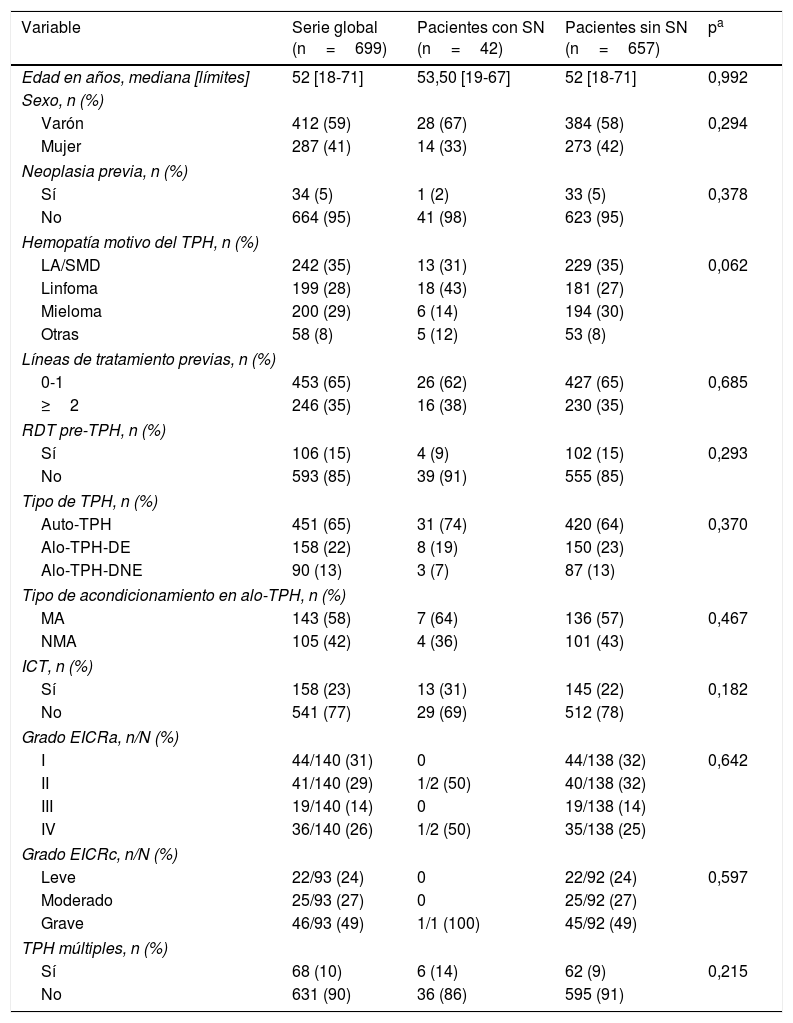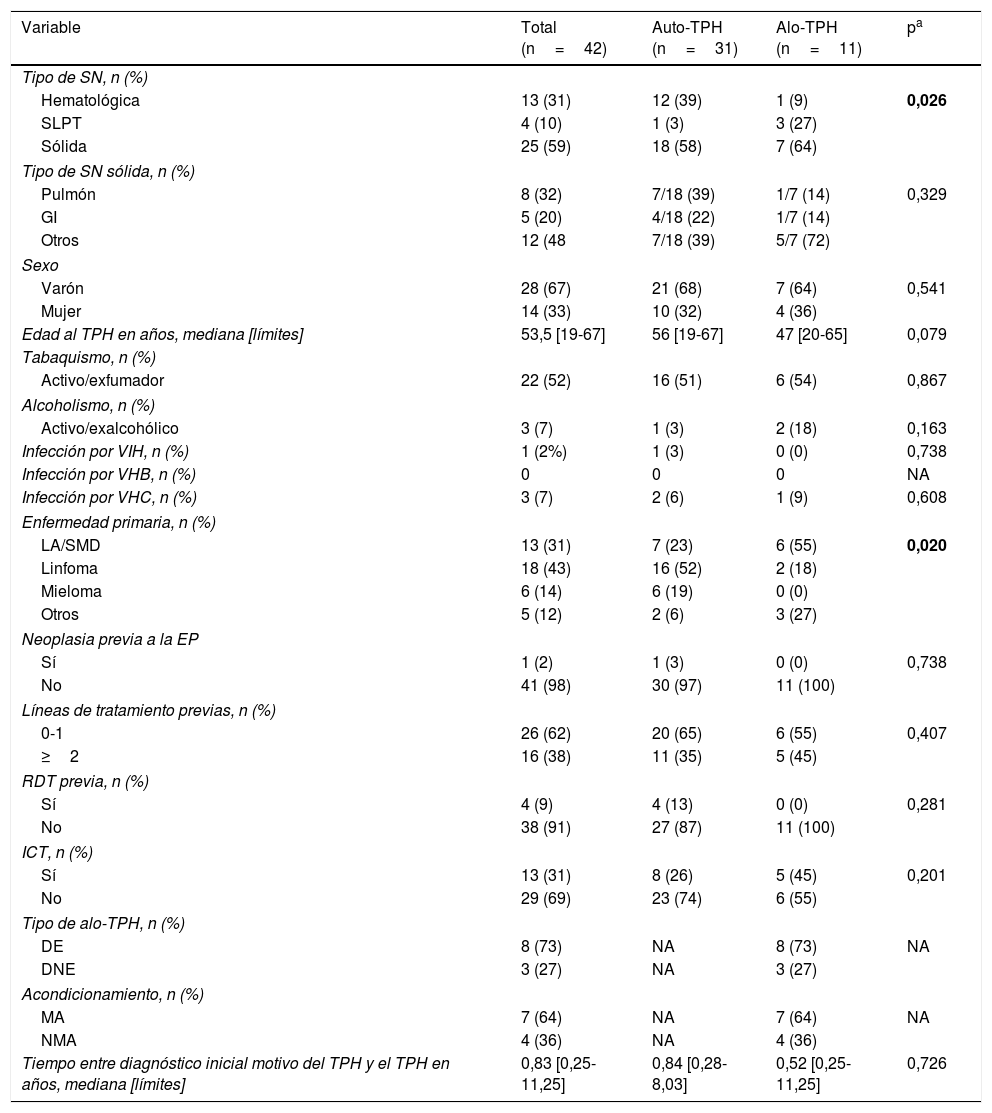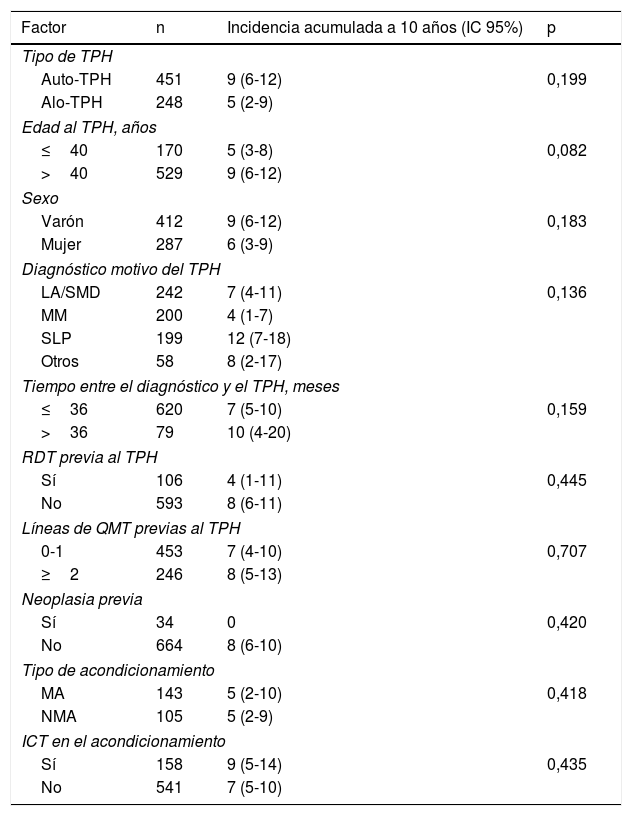Los receptores de un trasplante de progenitores hematopoyéticos (TPH) tienen un mayor riesgo de complicaciones tardías, como las segundas neoplasias (SN). Se analizó la incidencia de SN en pacientes receptores de un TPH en un centro.
Pacientes y métodosEstudio retrospectivo de pacientes adultos receptores de un primer TPH (autogénico [auto-TPH] o alogénico [alo-TPH]) entre enero de 2000 y diciembre de 2015. Se recogieron sus características demográficas, la enfermedad de base y el tipo de TPH, y se analizó la incidencia acumulada de SN y sus factores de riesgo.
ResultadosDe 699 pacientes receptores de un auto-TPH (n=451) o alo-TPH (n=248), 42 (6%) desarrollaron una SN (17 hematológicas y 25 sólidas), 31 postauto-TPH y 11 postalo-TPH. Se observó un mayor número de SN hematológicas tras auto-TPH que tras alo-TPH. La mediana de tiempo entre el TPH y la SN fue de 4,09 años [extremos 0,07-13,15], sin diferencias entre auto-TPH y alo-TPH. La incidencia acumulada de SN post-TPH fue de 5% (IC 95% 3-6) a 5 años, 7% (IC 95% 5-10) a 10 años y 11% (IC 95% 8-15) a 15 años, sin diferencias en función del tipo de TPH. Solo la edad superior a los 40 años se correlacionó con un mayor riesgo de SN.
ConclusionesEn esta serie, la incidencia de SN post-TPH fue similar a la descrita. Los receptores de un auto-TPH presentaron mayor frecuencia de SN hematológicas. Se detectó una mayor incidencia de SN en pacientes de más de 40 años en el momento del TPH.
Patients submitted to haematopoietic stem cell transplantation (HSCT) are at increased risk of late complications, such as second neoplasm (SN). The incidence and risk factors of SN in patients receiving HSCT at a single centre were analysed.
Patients and methodsThe follow-up of adult patients who received a first HSCT (autologous [auto-HSCT] or allogeneic [allo-HSCT]) between January 2000 and December 2015 was reviewed. We collected their demographic characteristics, the primary disease and type of HSCT, and analysed the cumulative incidence of SN and their risk factors.
ResultsOf 699 transplanted patients (auto-HSCT, n=451; allo-HSCT, n=248), 42 (6%) developed SN (17 haematological and 25 solid), 31 post-auto-HSCT and 11 post-allo-HSCT. Haematologic SN were more frequent after auto-HSCT than after allo-HSCT. The median time between HSCT and SN was 4.09 years [range 0.07-13.15], with no differences between auto-HSCT and allo-HSCT. The cumulative incidence of SN was 5% (95% CI 3-6) at 5 years, 7% (95% CI 5-10) at 10 years and 11% (95% CI 8-15) at 15 years, without differences according to the type of HSCT. Only the age over 40 years correlated with an increased risk of SN.
ConclusionsIn this series, the incidence of post-HSCT SN was similar to that previously described. Patients submitted to an auto-HSCT showed a higher frequency of haematologic SN. A higher incidence of SN was detected in patients older than 40 at the time of HSCT.
Artículo
Comprando el artículo el PDF del mismo podrá ser descargado
Precio 19,34 €
Comprar ahora










